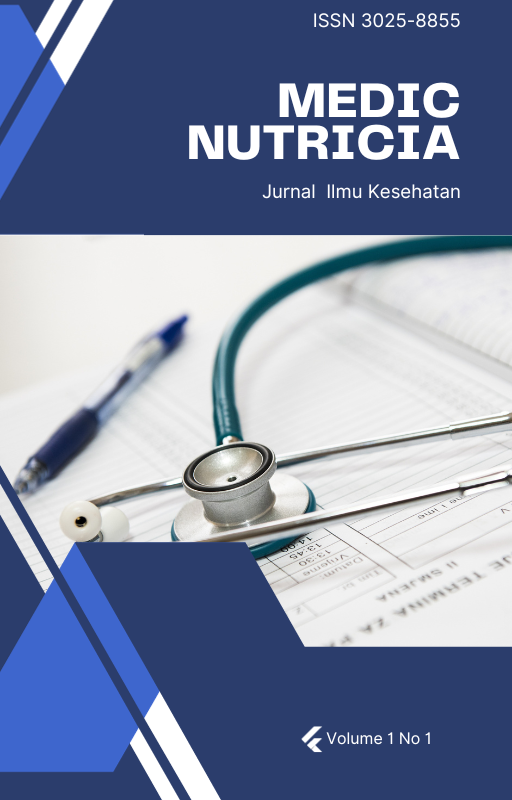DETEKSI FAKTOR RISIKO DEPRESI POSTPARTUM MENGGUNAKAN EDINBURGH POSTNATAL DEPRESSION SCALE (EPDS)
Main Article Content
Abstract
Peran baru menjadi seorang ibu dapat menimbulkan perasaan cemas yang dapat menimbulkan stres dan dapat memicu terjadinya gangguan kesehatan mental ibu nifas. Sekitar 10% wanita hamil dan 13% wanita yang baru saja melahirkan diseluruh dunia mengalami gangguan mental, terutama depresi. Tujuan penelitian ini adalah untuk mengetahui prevalensi serta faktor risiko yang mempengaruhi depresi postpartum pada ibu yang melahirkan di Kabupaten Tegal. Metode: penelitian ini merupakan deskriftif cross-sectional noneksperimental. Penelitian dimulai dari bulan Oktober – Desember 2024 di wilayah Kerja Puskesmas Bumijawa dan Bojong. Jumlah sampel pada penelitian ini adalah 44 ibu postpartum: Hasil penelitian didapatkan faktor-faktor yang dapat menyebabkan terjadinya risiko depresi pasca persalinan ialah; usia, paritas, pekerjaan, penghasilan, perencanaan kehamilan, cara persalinan dan berat lahir bayi.
Article Details

This work is licensed under a Creative Commons Attribution-NonCommercial 4.0 International License.

This work is licensed under a Creative Commons Attribution-NonCommercial-ShareAlike 4.0 International License.
References
K. Russell, A. Ashley, G. Chan, G. Gibson, and R. Jones, “Maternal Mental Health – Women’s Voices,” R. Collage Obstet. Ginaecologists, pp. 1–58, 2017, doi: 10.1145/1518701.1518861.
I. K. Prayoga, A. Dira, A. Ayu, and S. Wahyuni, “Prevalensi Dan Faktor Risiko Depresi Postpartum Di Kota Denpasar Menggunakan Edinburgh Postnatal Depression Scale Fakultas Kedokteran Universitas Udayana Bagian / SMF Ilmu Kedokteran Jiwa Fakultas Kedokteran Universitas Udayana / Rumah Sakit Umum Pusat Sa,” vol. 5, no. 7, pp. 5–9, 2016.
N. K. Özcan, N. E. Boyacıoğlu, and H. Dinç, “Postpartum Depression Prevalence and Risk Factors in Turkey: A Systematic Review and Meta-Analysis,” Arch. Psychiatr. Nurs., vol. 31, no. 4, pp. 420–428, 2017, doi: 10.1016/j.apnu.2017.04.006.
C. Carson, M. Redshaw, R. Gray, and M. A. Quigley, “Risk of psychological distress in parents of preterm children in the first year: evidence from the UK Millennium Cohort Study.,” BMJ Open, vol. 5, no. 12, p. e007942, Dec. 2015, doi: 10.1136/bmjopen-2015-007942.
C. Atuhaire and S. N. Cumber, “Factors associated with postpartum depression among adolescents in Uganda,” Pan Afr. Med. J., vol. 30, pp. 1–6, 2018, doi: 10.11604/pamj.2018.30.170.15333.
C. C. Dias and B. Figueiredo, “Breastfeeding and depression: a systematic review of the literature.,” J. Affect. Disord., vol. 171, pp. 142–54, Jan. 2015, doi: 10.1016/j.jad.2014.09.022.
S. Shorey, C. Y. I. Chee, E. D. Ng, Y. H. Chan, W. W. S. Tam, and Y. S. Chong, “Prevalence and incidence of postpartum depression among healthy mothers: A systematic review and meta-analysis,” J. Psychiatr. Res., vol. 104, pp. 235–248, 2018, doi: 10.1016/j.jpsychires.2018.08.001.
Who/Msd/Mer, “I mproving Maternal Mental Health,” p. 4, 2008.
National Collaborating Centre for Mental Health Royal College of Psychiatrists’ Research and Training, “Antenatal and Postnatal Mental Health: the Nice Guideline on Clinical Management,” Br. Psychol. Soc. R. Coll. Psychiatr., pp. 1–922, 2014, [Online]. Available: http://www.nice.org.uk/guidance/index.jsp?action=bypublichealth&PUBLICHEALTH=Mental+health#/search/?reload.
S. Brummelte and L. A. M. Galea, “Hormones and Behavior Postpartum depression : Etiology , treatment and consequences for maternal care,” Horm. Behav., vol. 77, pp. 153–166, 2016, doi: 10.1016/j.yhbeh.2015.08.008.
A. U. Ugarte et al., “Psychoeducational preventive treatment for women at risk of postpartum depression: study protocol for a randomized controlled trial, PROGEA.,” BMC Psychiatry, vol. 17, no. 1, p. 13, 2017, doi: 10.1186/s12888-016-1162-5.
D. de Camps Meschino, D. Philipp, A. Israel, and S. Vigod, “Maternal-infant mental health: postpartum group intervention,” Arch. Womens. Ment. Health, vol. 19, no. 2, pp. 243–251, 2016, doi: 10.1007/s00737-015-0551-y.
I. M. Bennett, W. Schott, S. Krutikova, and J. R. Behrman, “Maternal mental health, and child growth and development, in four low-income and middle-income countries,” J. Epidemiol. Community Health, vol. 70, no. 2, pp. 168–173, 2015, doi: 10.1136/jech-2014-205311.
T. Toru, F. Chemir, and S. Anand, “Magnitude of postpartum depression and associated factors among women in Mizan Aman town , Bench Maji zone , Southwest,” pp. 1–7, 2018.
S. Cici Mulyani1, Ayu Dekawaty2, “Faktor-Faktor Penyebab Depresi Pasca Persalinan,” J. Keperawatan Silampari, vol. 6, no. 1, pp. 635–649, 2022.
T. Field, “Postnatal anxiety prevalence, predictors and effects on development: A narrative review,” Infant Behav. Dev., vol. 51, no. February, pp. 24–32, 2018, doi: 10.1016/j.infbeh.2018.02.005.
E. O’Connor, R. C. Rossom, M. Henninger, H. C. Groom, and B. U. Burda, “Primary Care Screening for and Treatment of Depression in Pregnant and Postpartum Women: Evidence Report and Systematic Review for the US Preventive Services Task Force.,” JAMA, vol. 315, no. 4, pp. 388–406, Jan. 2016, doi: 10.1001/jama.2015.18948.
